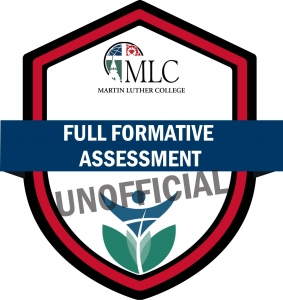MICRO-CREDENTIALS
Formal Recognition for Informal Learning
BDG0104 Full Formative Assessment
DESCRIPTION: Teachers who earn the Full Formative Assessment Micro-Credential check all students for a full or complete understanding of the learning target near the end of the lesson and use responses to adjust the lesson and increase student learning.
EARNING THE MICRO-CREDENTIAL: To earn the Full Formative Assessment Micro-Credential, teachers demonstrate that they can plan and implement full checks for understanding that align to the learning target and gather evidence of learning from all students. They also demonstrate that they can use student responses to either provide instructive feedback or to revise the lesson in progress to increase student learning. A full formative assessment is equivalent to what Moss & Brookhart (2009) call a Performance of Understanding and is not an assignment or something to be completed by students after the class is over. Appropriate examples may be a demonstration of the lesson skill, a non-graded quiz, a debate, or a written response to a question that may be done individually or in small groups.
Earners write a partial lesson plan including a formative assessment of the entire learning target near the end of the lesson, explaining three things: 1) how the assessment aligns to the entire learning target, 2) how the student data will reveal student understanding or misunderstanding of the entire lesson, and 3) what the teacher will say or do to remediate any misunderstandings. The earner video-records the planned lesson to demonstrate the ability to employ full formative assessments and to use the results to inform instruction during the lesson. Teachers must obtain parent permission to video-record students.
RESEARCH BASE: The research base for formative assessments is strong. Black & Wiliam (1998) first demonstrated the powerful research (see below). Black and Wiliam’s (1998) seminal article (below) outlines the initial research. Effect sizes on learning have been shown to be anywhere from .2 (Kingston & Nash, 20111) to .87 (Graham, Hiebert, & Harris, 2015). A nice summary of the research base is provided by Ryerse and Brookhart (2018). See below.
Black, P., & Wiliam, D. (1998) Inside the black box: Raising standards through classroom assessment. Phi Delta Kappan. 80 (2). pp. 139- 148 http://www.wyoaac.org/Lit/Inside%20the%20Black%20Box%20-%20Black.pdf
Ryerse, M., Brookhart, S. (2018) The research base for formative assessment. Getting Smart blog article. Retrieved from https://www.gettingsmart.com/2018/07/the-research-base-for-formative-assessment/
BACKGROUND: The following are useful tools to understand more about the topic.
- Video: Module 3: Assessment: https://vimeo.com/176207872 (password “assessment”)
- Knowing Your Learning Target, Educational Leadership March 2011, pp. 66-69 (Moss, Brookhart & Long) – Focus on the Performance of Understanding section.
- Learning Targets: Delving Deeper into the Performance of Understanding. (2013) LinkedIn Slideshare.
- 56 Different Examples of Formative Assessment (n.d.) Wees, David.
- Learning Targets: Helping Students Aim for Understanding in Today’s Lesson. Chapter Three (Moss & Brookhart, 2012)
- Advancing Formative Assessment in Every Classroom: Chapter One (Moss & Brookhart, 2009)
MICRO-CREDENTIAL CRITERIA: A Full Formative Assessment Micro-Credential earner can do the following:
- Plan an appropriate full check for understanding.
- Align the full check for understanding to the learning target.
- Reveal each student’s level of understanding or performance of the learning target.
- Use the assessment results to improve student learning.
SKILL DEMONSTRATION:
- Submit a lesson plan
Create a simple lesson plan that includes the following:
- The lesson target or objective.
- The full check for understanding.
- An explanation of how the assessment provides evidence of learning target mastery.
- An explanation of how student responses will be used to assess learning and adjust the lesson.
- Submit a lesson video
Keep in mind the following:
- Teach and video-record the planned lesson.
- Obtain permission for students to be video-recorded.
- Show the full formative assessment and resulting instructor follow-up.
- Edit the video so it is no more than 15 minutes long.
- Submit a written reflection
After completing the recorded lesson, write a written reflection (maximum: 400 words) of the lesson that explains:
- The impact of the full formative assessment on the lesson.
- The impact of the full formative assessment on student learning.
- The change(s) that can be made to improve the use of full formative assessments.
RUBRIC:
RESOURCES:
Books
Dodge, J. (2009) 25 quick formative assessments for a differentiated classroom. Scholastic https://www.amazon.com/Quick-Formative-Assessments-Differentiated-Classroom/dp/0545087422
Moss, C., and Brookhart, S. (2009) Advancing formative assessment in every classroom: A guide for instructional leaders. Alexandria VA. ASCD http://www.ascd.org/publications/books/109031.aspx
Articles
Black, P., & Wiliam, D. (1998) Inside the black box: Raising standards through classroom assessment. Phi Delta Kappan. 80 (2). pp. 139- 148 http://www.wyoaac.org/Lit/Inside%20the%20Black%20Box%20-%20Black.pdf
Dodge, Judith What are Formative Assessments and How Should We Use Them? Scholastic Teacher Resources. (http://www.scholastic.com/teachers/article/what-are-formative-assessments-and-why-should-we-use-them
Dyer, K. (2013) Formative Assessment – What it is, why you should use it, and how to make it happen. The Education Blog. https://www.nwea.org/blog/2013/formative-assessment-what-it-is-why-you-should-use-it-and-how-to-make-it-happen/
Meyer, J. (2012) What’s Up with Formative Assessment?
Popham, W.J. (2008) Chapter 1: Formative Assessment: Why, What, and Whether? Transformative Assessment. Transformative Assessment. http://www.ascd.org/publications/books/108018/chapters/Formative-Assessment@-Why,-What,-and-Whether.aspx
Videos
Assessment by Susan Brookhart: https://www.youtube.com/watch?v=9OLVf6s7crE
Giving Effective Feedback by Susan Brookhart: https://www.youtube.com/watch?v=jYQE73yhu7g
Formative Assessment Strategies: https://www.youtube.com/watch?v=JBtM7hpGXtA
Embedding Formative Assessment into Classroom Practice by Dylan Wiliam: http://www.dylanwiliamcenter.com/webinar-embedding-formative-assessment-into-classroom-practice/
Module 3: Assessment by John Meyer: https://vimeo.com/176207872 (password “assessment”)
Martin Luther College Courses
EDU9520 Formative Assessment that Works – 1 credit (continuing education)
EDU5106 Assessment of Learning and Instruction – 3 credits (graduate level)




